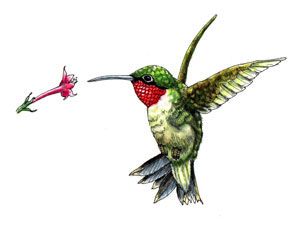 |
The brilliant, jewel-toned iridescent colors of tiny hummingbirds suggest their tropical origins. Of the hundreds of kinds resident in South and Central America only a few species migrate as far north as the United States to breed and raise young. As they follow each new season north they visit the newly opening flowers for nectar, pollinating them as they go. Researchers theorize that tubular flowers evolved as hummingbirds did, their special adaptation to their long beaks suiting the hummers' needs and minimizing competition for the precious nectar.
Hummers are remarkable as one of the smallest possible warm-blooded animals, maintaining just enough body mass to provide sufficient energy to sustain their lives. Their hearts beat 500 times per minute as they flap their wings 70 times a second to maintain flight. Because their wings are jointed at the shoulder, they can rotate them in all directions. They can fly backwards, upside down and straight up. They can hover and also stop on a dime.
Hummingbirds tend to be highly territorial, aggressively defend nesting and feeding ranges if necessary. They must eat constantly; the high calorie simple carbohydrate in flower nectar is high calorie and fast burning. They supplement this with protein from insects found in the flower nectar and plant sap. Humming birds will live 3 to 5 years.
Recognizing Hummingbirds
Ruby-throated hummingbirds (Archilochus colubris) are the only hummers that frequent the East during their breeding season. A diminutive 3 inches long, their name comes from the male's distinctive red throat. Both sexes have white bellies and greenish iridescent backs. Females have white-tipped tail feathers. Ruby-throats reside in mixed woodlands and orchards and visit yards with flowers.
Anna’s hummingbirds (Calypte anna) live primarily in California but venture inland as far as Arizona. Among the largest American hummers, they are also one of the few which do not migrate. In sunlight they show iridescent caps and red throats. Both sexes have green backs and sides, females showing specks of rose-red on their gray breasts. Anna’s frequent yards, but also canyons, foothills, river bottoms and, after breeding season, high coniferous forests.
Black-chinned hummingbirds (Archilocus alexandri) summer in Texas and winter in Mexico. They resemble ruby-throats, except that they have violet throats beneath black chins. Black-chins favor arid areas in the western mountains--open woodlands, scrub, desert washes, chaparral and parks and gardens.
Interesting Annual Event
Rockport and Fulton Texas celebrate the launch of the hummers each fall. Call 1-800-242-0071 for the date of the celebration each September. The hummers gather there prior to their long flight across the Gulf of Mexico. Some hummingbirds fly 5,000 miles, from Alaska to South America, on their fall and spring migrations.

